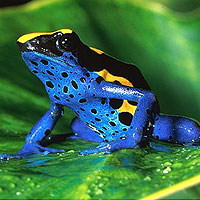Amphibians - Arrow Poison Frog
 Region:
South and Central America Region:
South and Central America
Class: Amphibia
Order: Anura
Family: Dendrobatidae
Genus: Dendrobates
Scientific Name: Latin: Dendrobates auratus French: Dendobate
dore
Description: Characterized by a pair of plate-like scutes
on the upper side of each finger and toe. Dendrobates
are separated from other frogs in that they lack teeth.
Length: 2.5 to 5.0 cm. (.9-1.9 ins.)
Distribution: New World tropics. Central and northern
South America. Panama to Ecuador and to the mouth of the
Amazon.
Habitat: Forsest floor, among leaf litter
Food: Small insects
Skin/Color/Coat: Small, usually colourful and quite slender.
Species at Toronto Zoo is black with emerald green patches.
Reproduction and Development: After the eggs are laid,
the male fertilizes them and carries them on his back.
There they eventually hatch, without immersion in water,
except for rain. The young number 2 to 20. The larvae
gain a hold on the male's back from mucus secreted by
the male. The young feed from the yolk sac of the egg.
If a tadpole drops off during this stage, it will not
survive. At a rather advanced stage, they are ready to
drop off. The male then immerses himself and the tadpoles
in water and they float off independently. They are adults
in about one year.
Adaptations: It is thought that the bright colours are
warnings to other animals that they are not fit to eat.
The colours are not visible at night and the poison allows
them to be diurnal rather than nocturnal like most other
frogs. Their venom is located in the skin and is released
on contact, attacking the neuromuscular apparatus of an
enemy via the bloodstream. The practice of the male carrying
the eggs on his back cuts down on the amount of time spent
as defenseless eggs and tadpoles in waters that teem with
predators. As a result, these frogs can make do with fewer
eggs and thus spawn larger ones, which supply more yolk
for each developing embryo.
Threats: These frogs, due to their warning colouration,
live a much safer life in the hazardous jungle than other
frogs. However, they are over collected for the pet/zoo
market. Also extensive jungle clearance destroys the humid
understory they require. The common name of the genus
indicates one use to which South American Indians put
these frogs. The authority, Doris M. Cochran, describes
this genus: " The Dendrobatins are the true poison
murderers. The South American Indians used the cutaneous
poison for their arrow tips long before white man's arrival.
The Indians kill the frogs by impaling them on a stick
and holding them over a fire. The heat causes the poison
to drip from the cutaneous glands into a vessel in which
it is kept while fermentation occurs. Finally the arrow
tips are dipped in the liquid and are dried. A monkey
or bird struck with such an arrow is paralyzed almost
immediately. Small quantities of poison have little effect
on larger animals or humans." Another use to which
the poison is put is for "dyeing" green Amazon
parrots. The green and blue feathers on the head and neck
are plucked out and these places are rubbed with the poison,
often simply with the living frog. This is repeated when
the new, young feathers grow in. The result is that these
feathers appear yellow instead of green. The Brazilians
are partial to these "freaks" or "contrafeitos"
and a considerable industry exists. (Amphibia and Reptiles
- Gadow, 1968).
Status: Common
References: Breen, John F, Encyclopedia of Reptiles and
Amphibians, T.F.H. Publications Inc., Hong Kong. Cochrane,
Doris M., Living Amphibians of the World, Doubleday Gadow,
Amphibians and Reptiles, Weldon and Wesley, England Grzimek's
Animal Life Encyclopedia Volume 5 Smith, H. Rucker, Amphibians
and Their Ways, MacMillan Life - Nature Library, "South
America" |
|
|
